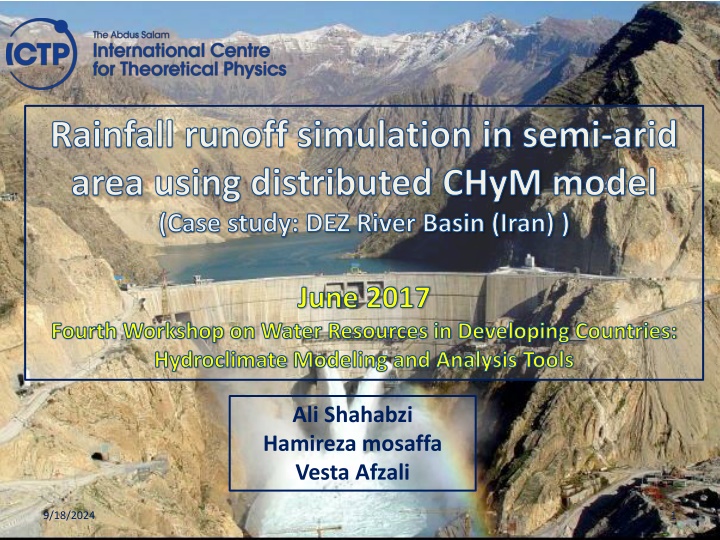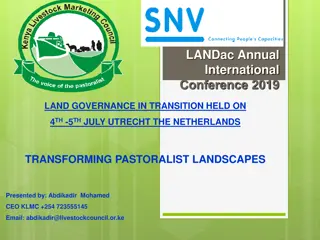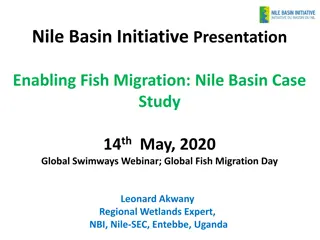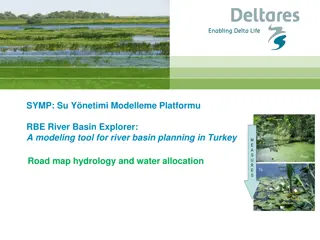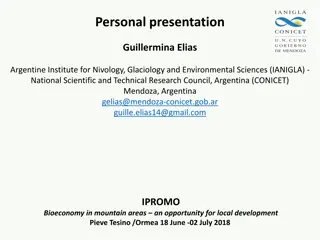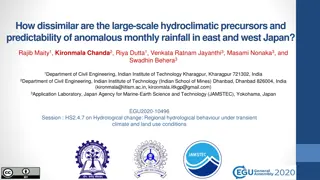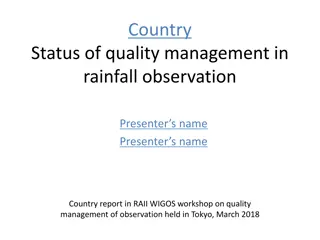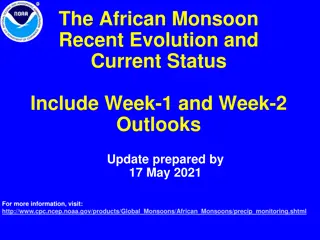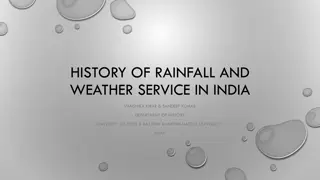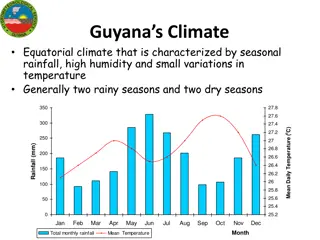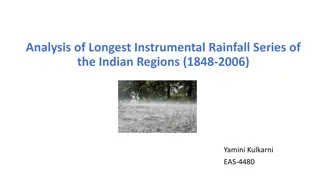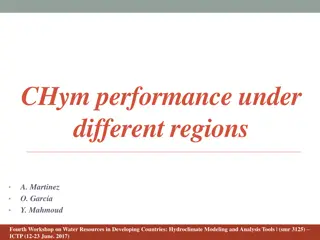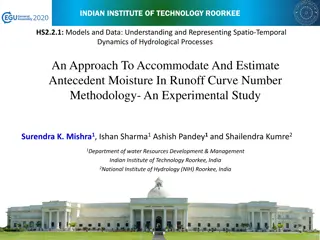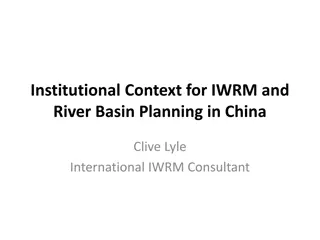Rainfall-Runoff Simulation in Semi-Arid Area Using Distributed CHyM Model: DEZ River Basin Study
"This case study delves into the simulation of rainfall-runoff using the CHyM model in the semi-arid area of the DEZ River Basin in Iran. The study focuses on water resources management, flood control, and forecasting of flood discharge parameters, emphasizing the importance of accurate modeling for effective water resource planning and management in developing countries."
Download Presentation

Please find below an Image/Link to download the presentation.
The content on the website is provided AS IS for your information and personal use only. It may not be sold, licensed, or shared on other websites without obtaining consent from the author.If you encounter any issues during the download, it is possible that the publisher has removed the file from their server.
You are allowed to download the files provided on this website for personal or commercial use, subject to the condition that they are used lawfully. All files are the property of their respective owners.
The content on the website is provided AS IS for your information and personal use only. It may not be sold, licensed, or shared on other websites without obtaining consent from the author.
E N D
Presentation Transcript
Rainfall runoff simulation in semi-arid area using distributed CHyM model (Case study: DEZ River Basin (Iran) ) June 2017 Fourth Workshop on Water Resources in Developing Countries: Hydroclimate Modeling and Analysis Tools Ali Shahabzi Hamireza mosaffa Vesta Afzali 9/18/2024 1
Introduction Rainfall & discharge variability Model setup and configuration Results Conclusion Fourth Workshop on Water Resources in Developing Countries: Hydroclimate Modeling and Analysis Tools 9/18/2024 2
Introduction Water Budget :7.5 billion m3/y Total Capacity Dam: 2.7 billion m3 Area of Dez Basin:17,600 km3 Sezar + Bakhtiari= Dez Sezar Inflow of DEZ Basin: Bakhtiari Inflow Bakhtiari: 4346 mcm Rodbar Tange panj Inflow Sezar: 1998 mcm Zalaki Talezang Liro Mid flow 1156 mcm Sum: 7500mcm Fourth Workshop on Water Resources in Developing Countries: Hydroclimate Modeling and Analysis Tools 9/18/2024 3
Introduction Why this area ?!!! Why flood study ?!!! In comparison with the total inflow, Dez dam capacity is very low so spill is very frequent Base on dam rule curve we need a big amount of flood control volume in rainy season In late of rainy season it means we can lose the opportunity of fulfilling dam and encountering drought in down stream If We do not obey the rule curve flooding downstream is a high risk (like 2016 Jan. flood) So we need forecasting of flood discharge parameters (like volume and peak); in this step rainfall-runoff model have a vital rule Fourth Workshop on Water Resources in Developing Countries: Hydroclimate Modeling and Analysis Tools 9/18/2024 4
Introduction Rainfall & discharge variability Model setup and configuration Results Conclusion Fourth Workshop on Water Resources in Developing Countries: Hydroclimate Modeling and Analysis Tools 9/18/2024 5
Rainfall & discharge Fourth Workshop on Water Resources in Developing Countries: Hydroclimate Modeling and Analysis Tools 9/18/2024 6
Rainfall & discharge Wet and dry periods in 50 years Fourth Workshop on Water Resources in Developing Countries: Hydroclimate Modeling and Analysis Tools 9/18/2024 7
Introduction Rainfall & discharge variability Model setup and configuration Results Conclusion Fourth Workshop on Water Resources in Developing Countries: Hydroclimate Modeling and Analysis Tools 9/18/2024 8
Model setup & configuration To preparing to model for simulating a specific period or flood event We need a model warmup at a longer period of time to adjust initial condition of favored event. In this study first we consider 1 year to spin up but because of area of domain, model runs have taken so much time. So we consider only 3 month to spin up. Fourth Workshop on Water Resources in Developing Countries: Hydroclimate Modeling and Analysis Tools 9/18/2024 9
Model setup & configuration Rainfall: TRMM DEM: Hydroshed Temprature: ERAI Start date: 2011.01.01 Date of event 1 March to 17 March 2011 Fourth Workshop on Water Resources in Developing Countries: Hydroclimate Modeling and Analysis Tools 9/18/2024 10
Model setup & configuration nlon nlat dij CHYM steps infiltra Return flow factor 1 836 622 0.00225 50 0.0015 40 4.8 * 10^-7 2 836 622 0.00225 80 0.0015 40 4.8 * 10^-7 3 836 622 0.00225 120 0.0015 40 4.8 * 10^-7 4 418 311 0.0045 120 0.0015 40 4.8 * 10^-7 5 209 156 0.009 120 0.0015 40 4.8 * 10^-7 6 418 311 0.0045 120 0.0015 80 4.8 * 10^-7 7 418 311 0.0045 120 0.0015 100 4.8 * 10^-7 8 418 311 0.0045 120 0.001 40 4.8 * 10^-7 9 418 311 0.0045 120 0.0013 40 4.8 * 10^-7 10 418 311 0.0045 120 0.0015 100 4.8 * 10^-7 11 418 311 0.0045 120 0.0015 100 2.8 * 10^-7 12 418 311 0.0045 120 0.0015 100 6.8 * 10^-7 Fourth Workshop on Water Resources in Developing Countries: Hydroclimate Modeling and Analysis Tools 9/18/2024 11
Introduction Rainfall & discharge variability Model setup and configuration Results Conclusion Fourth Workshop on Water Resources in Developing Countries: Hydroclimate Modeling and Analysis Tools 9/18/2024 12
Accumulated discharge during simulation period pixel size ( 900m) Fourth Workshop on Water Resources in Developing Countries: Hydroclimate Modeling and Analysis Tools 9/18/2024 13
Accumulated discharge during simulation period pixel size ( 225m) T=50 Fourth Workshop on Water Resources in Developing Countries: Hydroclimate Modeling and Analysis Tools 9/18/2024 14
Accumulated discharge during simulation period pixel size( 225m) T=80 Fourth Workshop on Water Resources in Developing Countries: Hydroclimate Modeling and Analysis Tools 9/18/2024 15
Accumulated discharge during simulation period pixel size ( 225m) T=120 Fourth Workshop on Water Resources in Developing Countries: Hydroclimate Modeling and Analysis Tools 9/18/2024 16
Accumulated discharge during simulation period pixel size ( 450 m) Fourth Workshop on Water Resources in Developing Countries: Hydroclimate Modeling and Analysis Tools 9/18/2024 17
Effect of changing infiltration parameter in output hydrograph 40 80 100 OBS Fourth Workshop on Water Resources in Developing Countries: Hydroclimate Modeling and Analysis Tools 9/18/2024 18
Effect of changing return flow parameter in output hydrograph OBS 4.8*10^-7 6.8*10^-7 Fourth Workshop on Water Resources in Developing Countries: Hydroclimate Modeling and Analysis Tools 9/18/2024 19
Introduction Rainfall & discharge variability Model setup and configuration Results Conclusion Fourth Workshop on Water Resources in Developing Countries: Hydroclimate Modeling and Analysis Tools 9/18/2024 20
Conclusion Chym Model estimates precisely peaks of Hydrographs for the mentioned basin More and more study Sensitivity Analysis Validation Fourth Workshop on Water Resources in Developing Countries: Hydroclimate Modeling and Analysis Tools 9/18/2024 21
Fourth Workshop on Water Resources in Developing Countries: Hydroclimate Modeling and Analysis Tools 9/18/2024 22
